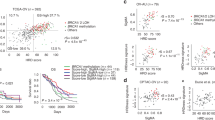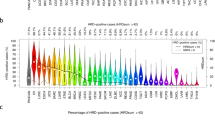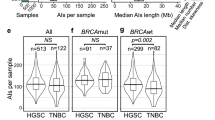Abstract
Background
Molecular alterations leading to homologous recombination deficiency (HRD) are heterogeneous. We aimed to identify a transcriptional profile shared by endometrial (UCEC), breast (BRCA) and ovarian (OV) cancers with HRD.
Methods
Genes differentially expressed with HRD genomic score (continuous gHRD score) in UCEC/BRCA/OV were identified using edgeR, and used to train a RNAseq score (ridge-regression model) predictive of the gHRD score (PanCanAtlas, N = 1684 samples). The RNAseq score was applied in independent gynaecological datasets (CARPEM/CPTAC/SCAN/TCGA, N = 4038 samples). Validations used ROC curves, linear regressions and Pearson correlations. Overall survival (OS) analyses used Kaplan–Meier curves and Cox models.
Results
In total, 656 genes were commonly up/downregulated with gHRD score in UCEC/BRCA/OV. Upregulated genes were enriched for nuclear/chromatin/DNA-repair processes, while downregulated genes for cytoskeleton (gene ontologies). The RNAseq score correlated with gHRD score in independent gynaecological cancers (R² = 0.4–0.7, Pearson correlation = 0.64–0.86, all P < 10−11), and was predictive of gHRD score >42 (RNAseq HRD profile; AUC = 0.95/0.92/0.78 in UCEC/BRCA/OV). RNAseq HRD profile was associated (i) with better OS in platinum-treated advanced TP53-mutated-UCEC (P < 0.001) and OV (P = 0.013), and (ii) with poorer OS (P < 0.001) and higher benefit of adjuvant chemotherapy in Stage I–III BRCA (interaction test, P < 0.001).
Conclusions
UCEC/BRCA/OV with HRD-associated genomic scars share a common transcriptional profile. RNAseq signatures might be relevant for identifying HRD-gynaecological cancers, for prognostication and for therapeutic decision.
This is a preview of subscription content, access via your institution
Access options
Subscribe to this journal
Receive 24 print issues and online access
$259.00 per year
only $10.79 per issue
Buy this article
- Purchase on Springer Link
- Instant access to full article PDF
Prices may be subject to local taxes which are calculated during checkout





Similar content being viewed by others
Data availability
Materials, data, and protocols described in the manuscript will be made available upon reasonable request at the corresponding author. Full details on data generation and data quality have been reported elsewhere [27]. The R objects to be used for the prediction on external data are provided as Supplementary Data 2.
References
Knijnenburg TA, Wang L, Zimmermann MT, Chambwe N, Gao GF, Cherniack AD, et al. Genomic and molecular landscape of DNA damage repair deficiency across The Cancer Genome Atlas. Cell Rep. 2018;23:239–54.e6.
Timms KM, Abkevich V, Hughes E, Neff C, Reid J, Morris B, et al. Association of BRCA1/2 defects with genomic scores predictive of DNA damage repair deficiency among breast cancer subtypes. Breast Cancer Res. 2014;16:475.
Watkins JA, Irshad S, Grigoriadis A, Tutt AN. Genomic scars as biomarkers of homologous recombination deficiency and drug response in breast and ovarian cancers. Breast Cancer Res. 2014;16:211.
de Jonge MM, Auguste A, van Wijk LM, Schouten PC, Meijers M, ter Haar NT, et al. Frequent homologous recombination deficiency in high-grade endometrial carcinomas. Clin Cancer Res. 2019;25:1087–97.
Siedel JH, Ring KL, Hu W, Dood RL, Wang Y, Baggerly K, et al. Clinical significance of homologous recombination deficiency score testing in endometrial Cancer. Gynecol Oncol. 2021;160:777–85.
Sokol ES, Pavlick D, Khiabanian H, Frampton GM, Ross JS, Gregg JP, et al. Pan-cancer analysis of BRCA1 and BRCA2 genomic alterations and their association with genomic instability as measured by genome-wide loss of heterozygosity. JCO Precision Oncol. 2020;4:442–65.
Jones NL, Xiu J, Reddy SK, Burke WM, Tergas AI, Wright JD, et al. Identification of potential therapeutic targets by molecular profiling of 628 cases of uterine serous carcinoma. Gynecol Oncol. 2015;138:620–6.
Tutt A, Tovey H, Cheang MCU, Kernaghan S, Kilburn L, Gazinska P, et al. Carboplatin in BRCA1/2-mutated and triple-negative breast cancer BRCAness subgroups: the TNT Trial. Nat Med. 2018;24:628–37.
Telli ML, Timms KM, Reid J, Hennessy B, Mills GB, Jensen KC, et al. Homologous recombination deficiency (HRD) score predicts response to platinum-containing neoadjuvant chemotherapy in patients with triple-negative breast cancer. Clin Cancer Res. 2016;22:3764–73.
Robson M, Im SA, Senkus E, Xu B, Domchek SM, Masuda N, et al. Olaparib for metastatic breast cancer in patients with a germline BRCA mutation. N. Engl J Med 2017;377:523–33.
Ray-Coquard I, Pautier P, Pignata S, Pérol D, González-Martín A, Berger R, et al. Olaparib plus bevacizumab as first-line maintenance in ovarian cancer. N. Engl J Med. 2019;381:2416–28.
González-Martín A, Pothuri B, Vergote I, DePont Christensen R, Graybill W, Mirza MR, et al. Niraparib in patients with newly diagnosed advanced ovarian cancer. N. Engl J Med. 2019;381:2391–402.
Hoppe MM, Sundar R, Tan DSP, Jeyasekharan AD. Biomarkers for homologous recombination deficiency in cancer. JNCI: J Natl Cancer Inst. 2018;110:704–13.
Eccles DM, Mitchell G, Monteiro ANA, Schmutzler R, Couch FJ, Spurdle AB, et al. BRCA1 and BRCA2 genetic testing—pitfalls and recommendations for managing variants of uncertain clinical significance. Ann Oncol. 2015;26:2057–65.
Sakai W, Swisher EM, Karlan BY, Agarwal MK, Higgins J, Friedman C, et al. Secondary mutations as a mechanism of cisplatin resistance in BRCA2-mutated cancers. Nature. 2008;451:1116–20.
Drost R, Bouwman P, Rottenberg S, Boon U, Schut E, Klarenbeek S, et al. BRCA1 RING function is essential for tumor suppression but dispensable for therapy resistance. Cancer Cell. 2011;20:797–809.
Labidi-Galy SI, Olivier T, Rodrigues M, Ferraioli D, Derbel O, Bodmer A, et al. Location of mutation in BRCA2 gene and survival in patients with ovarian cancer. Clin Cancer Res. 2018;24:326–33.
Sztupinszki Z, Diossy M, Börcsök J, Prosz A, Cornelius N, Kjeldsen MK, et al. Comparative assessment of diagnostic homologous recombination deficiency associated mutational signatures in ovarian cancer. Clin Cancer Res. 2021;27:5681–87.
Coleman RL, Oza AM, Lorusso D, Aghajanian C, Oaknin A, Dean A, et al. Rucaparib maintenance treatment for recurrent ovarian carcinoma after response to platinum therapy (ARIEL3): a randomised, double-blind, placebo-controlled, phase 3 trial. Lancet. 2017;390:1949–61.
Miller RE, Leary A, Scott CL, Serra V, Lord CJ, Bowtell D, et al. ESMO recommendations on predictive biomarker testing for homologous recombination deficiency and PARP inhibitor benefit in ovarian cancer. Ann Oncol. 2020;31:1606–22.
Pettitt SJ, Frankum JR, Punta M, Lise S, Alexander J, Chen Y, et al. Clinical BRCA1/2 reversion analysis identifies hotspot mutations and predicted neoantigens associated with therapy resistance. Cancer Discov. 2020;10:1475–88.
Jazaeri AA, Yee CJ, Sotiriou C, Brantley KR, Boyd J, Liu ET. Gene expression profiles of BRCA1-linked, BRCA2-linked, and sporadic ovarian cancers. J Natl Cancer Inst. 2002;94:990–1000.
Konstantinopoulos PA, Spentzos D, Karlan BY, Taniguchi T, Fountzilas E, Francoeur N, et al. Gene expression profile of BRCAness that correlates with responsiveness to chemotherapy and with outcome in patients with epithelial ovarian cancer. JCO. 2010;28:3555–61.
Severson TM, Wolf DM, Yau C, Peeters J, Wehkam D, Schouten PC, et al. The BRCA1ness signature is associated significantly with response to PARP inhibitor treatment versus control in the I-SPY 2 randomized neoadjuvant setting. Breast Cancer Res. 2017;19:99.
Peng G, Chun-Jen Lin C, Mo W, Dai H, Park YY, Kim SM, et al. Genome-wide transcriptome profiling of homologous recombination DNA repair. Nat Commun. 2014;5:3361.
Clinical Proteomic Tumor Analysis Consortium (CPTAC) | NCI Genomic Data Commons [Internet]. [cité 24 août 2021]. Disponible sur: https://gdc.cancer.gov/about-gdc/contributed-genomic-data-cancer-research/clinical-proteomic-tumor-analysis-consortium-cptac
Beinse G, Belda MALF, Just PA, Bekmezian N, Koual M, Garinet S, et al. Development and validation of a RNAseq signature for prognostic stratification in endometrial cancer. Gynecologic Oncol. 2022. Disponible sur: https://www.gynecologiconcology-online.net/article/S0090-8258(22)00006-3/fulltext
Saal LH, Vallon-Christersson J, Häkkinen J, Hegardt C, Grabau D, Winter C, et al. The Sweden Cancerome Analysis Network - Breast (SCAN-B) Initiative: a large-scale multicenter infrastructure towards implementation of breast cancer genomic analyses in the clinical routine. Genome Med. 2015;7:20.
Repository [Internet]. [cité 24 août 2021]. Disponible sur: https://portal.gdc.cancer.gov/repository
GEO Accession viewer [Internet]. [cité 24 août 2021]. Disponible sur: https://www.ncbi.nlm.nih.gov/geo/query/acc.cgi
Kommoss S, McConechy MK, Kommoss F, Leung S, Bunz A, Magrill J, et al. Final validation of the ProMisE molecular classifier for endometrial carcinoma in a large population-based case series. Ann Oncol. 2018;29:1180–8.
Publication of the WHO Classification of Tumours, 5th Edition, Vol. 4: Female Genital Tumours – IARC [Internet]. [cité 4 août 2021]. Disponible sur: https://www.iarc.who.int/news-events/publication-of-the-who-classification-of-tumours-5th-edition-volume-4-female-genital-tumours/
Martin M. Cutadapt removes adapter sequences from high-throughput sequencing reads. EMBnet J. 2011;17:10–2.
Dobin A, Davis CA, Schlesinger F, Drenkow J, Zaleski C, Jha S, et al. STAR: ultrafast universal RNA-seq aligner. Bioinformatics. 2013;29:15–21.
Anders S, Pyl PT, Huber W. HTSeq—a Python framework to work with high-throughput sequencing data. Bioinformatics. 2015;31:166–9.
Robinson MD, McCarthy DJ, Smyth GK. edgeR: a Bioconductor package for differential expression analysis of digital gene expression data. Bioinformatics. 2010;26:139–40.
EaCoN [Internet]. Gustave Roussy; 2021 [cité 24 août 2021]. Disponible sur: https://github.com/gustaveroussy/EaCoN
Loo PV, Nordgard SH, Lingjærde OC, Russnes HG, Rye IH, Sun W, et al. Allele-specific copy number analysis of tumors. Proc Natl Acad Sci USA. 2010;107:16910–5.
Sztupinszki Z, Diossy M, Krzystanek M, Reiniger L, Csabai I, Favero F, et al. Migrating the SNP array-based homologous recombination deficiency measures to next generation sequencing data of breast cancer. npj Breast Cancer. 2018;4:1–4.
Brionne A, Juanchich A, Hennequet-Antier C. ViSEAGO: a Bioconductor package for clustering biological functions using Gene Ontology and semantic similarity. BioData Min. 2019;12:16.
Friedman J, Hastie T, Tibshirani R. Regularization paths for generalized linear models via coordinate descent. J Stat Soft. 2010;33. Disponible sur: http://www.jstatsoft.org/v33/i01/
Ballman KV. Biomarker: predictive or prognostic? JCO. 2015;33:3968–71.
Martens EP, Boer A, de, Pestman WR, Belitser SV, Stricker BHC, Klungel OH. Comparing treatment effects after adjustment with multivariable Cox proportional hazards regression and propensity score methods. Pharmacoepidemiol Drug Saf. 2008;17:1–8.
Park Y, Chui MH, Suryo Rahmanto Y, Yu ZC, Shamanna RA, Bellani MA, et al. Loss of ARID1A in tumor cells renders selective vulnerability to combined ionizing radiation and PARP inhibitor therapy. Clin Cancer Res. 2019;25:5584–94.
Dedes KJ, Wetterskog D, Mendes-Pereira AM, Natrajan R, Lambros MB, Geyer FC, et al. PTEN deficiency in endometrioid endometrial adenocarcinomas predicts sensitivity to PARP inhibitors. Sci Transl Med. 2010;2:53ra75.
Findlay GM, Daza RM, Martin B, Zhang MD, Leith AP, Gasperini M, et al. Accurate classification of BRCA1 variants with saturation genome editing. Nature. 2018;562:217–22.
Philip CA, Laskov I, Beauchamp MC, Marques M, Amin O, Bitharas J, et al. Inhibition of PI3K-AKT-mTOR pathway sensitizes endometrial cancer cell lines to PARP inhibitors. BMC Cancer. 2017;17:638.
Romero I, Rubio MJ, Medina M, Matias-Guiu X, Santacana M, Schoenenberger JA, et al. An olaparib window-of-opportunity trial in patients with early-stage endometrial carcinoma: POLEN study. Gynecol Oncol. 2020;159:721–31.
Takaya H, Nakai H, Takamatsu S, Mandai M, Matsumura N. Homologous recombination deficiency status-based classification of high-grade serous ovarian carcinoma. Sci Rep. 2020;10:2757.
Blanc-Durand F, Yaniz E, Genestie C, Rouleau E, Berton D, Lortholary A, et al. Evaluation of a RAD51 functional assay in advanced ovarian cancer, a GINECO/GINEGEPS study. JCO. 2021;39:5513–5513.
Patel JN, Braicu I, Timms KM, Solimeno C, Tshiaba P, Reid J, et al. Characterisation of homologous recombination deficiency in paired primary and recurrent high-grade serous ovarian cancer. Br J Cancer. 2018;119:1060–6.
Acknowledgements
The work was conducted in a research team supported by the Ligue Nationale Contre le Cancer (LNCC, Program “Equipe labelisée LIGUE”; no. EL2016.LNCC). FFPE sections were provided by the Biological Resources Centers and Tumour Bank Platforms of Cochin Hospital (BB-0033-00023 certification) and HEGP (BB-0033-00063 certification). RNA sequencing was performed at the sequencing platform of the Institut du Cerveau et de la Moelle Institute (Mr. Yannick Marie, Mme Mundwiller, CNRS UMR 7225—Inserm U 1127—Sorbonne Université UM75, Paris, France). Targeted sequencing and OncoScan microarray analyses have been performed at the GENOM’IC sequencing platform (Institut Cochin, U1016, Paris, France) and at the Department of Biochemistry and Molecular Oncology, Hopital Européen Georges Pompidou (APHP.Centre, Paris, France). Bioinformatical analyses used the French Institute of Bioinformatic clusters and local R studio on R v4. The authors would like to thank Mme De Jesus (Department of Gynaecological Surgery, Cochin Hospital), Mme Lannoy (Department of Medical Oncology, Cochin Hospital), Mme Philibert (Department of Gynecological Surgery, HEGP), Mme Hermary, Mme Le Lay (Tumour Bank Platform, Cochin Hospital), Mme Geromin, Mme Largeau, Dr. Védie, Mme Carron, Mme Le Dannois, Mme Valognes, Mme Moussy, Mme Bruneau, Mr. Maisonneuve, Mme Chabert (Tumour bank platform & pathology department, HEGP), Mme Leger, Mme Urban, Mme Goyer, Mme Auribault (Department of biochemistry/molecular oncology, HEGP), Mme Mulot, Mme Didelot, Mme Chaba, Mme Agueff, Mme Bourreau, Mme Mazoyer (Centre de Recherche des Cordeliers, Paris, France), Mr. Ladeiro and Mme Lusson (CARPEM) for their technical and administrative support. Data used in this publication were generated by the (i) National Cancer Institute Clinical Proteomic Tumour Analysis Consortium (CPTAC), (ii) the Cancer Genome Atlas, (iii) the Sweden Cancerome Analysis Network and (iv) the CARPEM institute.
Funding
This work was supported by ITMO Cancer AVIESAN (Alliance Nationale pour les Sciences de la Vie et de la Santé/ National Alliance for Life Sciences & Health) within the framework of the Cancer Plan and by GHU-Assistance Publique-Hopitaux de Paris Centre (translational research program). The work was conducted within the SIRIC CARPEM translational research platform.
Author information
Authors and Affiliations
Contributions
Conceptualisation: GB, BB and JA. Data curation: GB, P-AJ, M-ALFB, MK, SG and KL. Formal analysis: GB. Funding acquisition: GB and JA. Investigation: GB, PAJ, MALFB, MK, SG, PL-P, A-SB, BB, JA. Patient accrual and data collection: GB, MK, ND, CG, CD, CC, FG, A-SB, BB, JA. Methodology: GB, P-AJ, MALFB, PL-P, A-SB, BB, JA. Project administration: GB and JA. Resources: GB, PAJ, MALFB, MK, HB, SJ, BT, CB, PL-P, A-SB, BB and JA. Supervision: PL-P, BB and JA. Writing—original draft: GB and JA. Writing—review & editing: all authors.
Corresponding author
Ethics declarations
Competing interests
GB: institutional funding from ITMO Cancer AVIESAN (French National Cancer Institute); JA: research funding from MSD; advisory board: GSK, MSD, AstraZeneca, Clovis, Eisaï. No external entities had any role in the design and conduction of the study, the collection, management, analysis, and interpretation of the data, the preparation, review and approval of the manuscript or the decision to submit the manuscript for publication. The remaining authors declare no competing interests.
Ethics approval and consent to participate
Patients treated for Stage I–IV UCEC in two University Hospitals in Paris [2010–2017] were post hoc included and referred as to the CAncer Research for Personalised Medicine Institute upon written consent or non-opposition (CARPEM) cohort (ethical approvals from National Ethical Committee CPP Ile-de-France I II & IV, DC-2020/144; DC-2019-3677; DC-2009-950, Data Protection Committee approval ID APHP2020-1109121347).
Consent to publish
Not applicable.
Additional information
Publisher’s note Springer Nature remains neutral with regard to jurisdictional claims in published maps and institutional affiliations.
Rights and permissions
About this article
Cite this article
Beinse, G., Just, PA., Le Frere Belda, MA. et al. Discovery and validation of a transcriptional signature identifying homologous recombination-deficient breast, endometrial and ovarian cancers. Br J Cancer 127, 1123–1132 (2022). https://doi.org/10.1038/s41416-022-01900-9
Received:
Revised:
Accepted:
Published:
Issue Date:
DOI: https://doi.org/10.1038/s41416-022-01900-9



